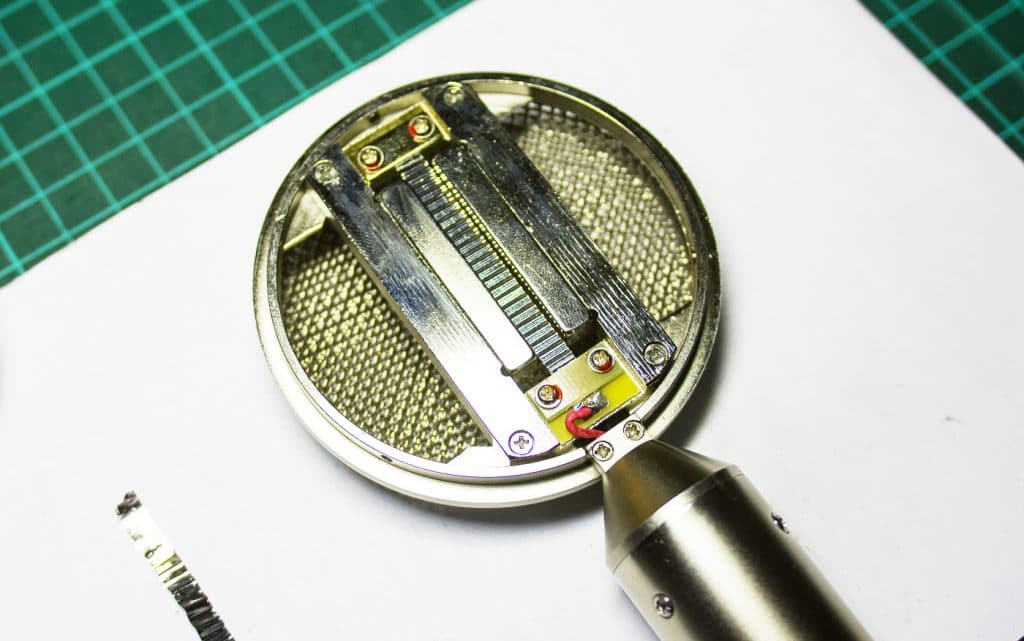How Aluminum Foil Thickness Affects The Performance of a Ribbon Microphone
- Author: Artur Fisher
- Published: November 22, 2015
- Updated: January 19, 2024
I often receive questions about the performance of different ribbon microphone foil thicknesses in ribbon mic motors. The main thing people are interested in is if thinner foils result in “more highs”. The answer is not as straight-forward as you might expect. So, I’ve tried to summarize my replies in this post in order to explain the basics of the topic.

Ribbon Microphone Foil - How its Thickness Affect the Performance & Sound Properties
Let’s start from the very basic fact that comes from the ribbon microphone physics. The frequency response of the plain motor (without body and transformer) is only determined by its mechanical shape. The start of high frequency roll-off is determined by the distance from the front of a ribbon to its back around the frame. The smaller is this distance, the higher frequency the motor can reproduce. That’s why many motors have a sand clock shape with a thin waist.
From this point of view, the only advantage of a thin ribbon microphone foil would be the higher output signal level, which is reversely proportional to the mass of the ribbon. Say, if we use 1.2 micron foil instead of 2.5 micron in the same motor, the output level will increase twice, e.g. +6db. The downside will be the same amount of increase in output impedance of the ribbon, as the crossection of the foil is reduced twice. Increased output impedance will call for a transformer with higher inductance in primary winding to maintain the same bass performance. If the primary inductance is not enough, the combination of motor and transformer will act as high-pass filter, e.g. you will experience some bass roll-off. Sometimes it can be desirable though…
Now, if you have done some research on foil thickness topic, I bet you have found many forum posts and articles (sometimes with audio samples) sharing the opinion that motors re-ribboned with thinner foils tend to sound better. Do all these people experience the “placebo effect”, including yourself while listening to samples? Well, the answer is no. However, the secret is not in frequency response domain, but in a much more important spec – the transient response.
Transient Response is The Key
The transient response is the ability of your microphone to reproduce very short initial spikes of the sounds. These spikes (transients) can be several times higher than the average SPL of the following sustain. If we talk in musical definitions of the attack and sustain, than the transient can be explained as the tiny fraction of time, the very beginning of the attack. Transients play a major part in sound of cymbals and acoustic guitars, as well as all the other finger picked stringed and percussive instruments.
Obviously that transients being very short and belonging mostly to the mid and high frequency domains carry a very small energy. While their proper reproduction is critical and often determines the subjective quality of sound. A track that lacks the properly recorded transients will sound dull and “plastic”. On the other hand, the well-recorded transients will make the track sound vivid, present and airy. A membrane with a lower mass needs less energy to get motivated. Obviously, it responds to the tiniest air pressure changes better than heavy membrane reproducing the transients more natural way.
The Conclusion
Taking the aforementioned facts into account, we can logically conclude that thinner ribbons do improve the sound. But it must be understood, that the improvement is not related to having more highs. It is the improvement in the quality of your high end, not in bandwidth. In simple terms, the high frequency roll-off of your microphone does not change. However, due to the improved transient response the detalization of high-mid and high ranges becomes significantly better. It can be clearly perceived and is often subjectively described as more highs or a brighter sound.
